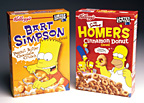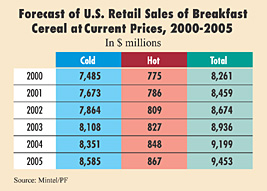Breakfast cereal manufacturers face a shrinking market, with intense competition from other options, including breakfast bars, bagels and muffins. The cost of cereal also has led consumers to rethink their choices, and many have turned to private-label varieties.
In its report on the U.S. breakfast cereal market, Mintel segments cereals by their method of preparation—cold or ready-to-eat (RTE) cereals and hot cereals. Cold cereals are, by far, the favored variety, accounting for more than 90% of total sales in 1999. Nonetheless, hot cereals have grown in appeal with the increased array of “instant” hot oatmeal.
In 1995, hot and cold cereals combined for $8.6 billion in sales, a number that fell to $8.1 billion by 1999. Manufacturers moved to expand the concept of cereal consumption in the morning to a fine snack at any time. In addition, realizing that cereal could well become a casualty of consumers' shift in eating habits, cereal manufacturers have heeded the call for convenience.
More people are looking for a quick meal they can eat on the way to work or school, hence the success and growth of toaster pastries, bagels, yogurt and fruit as breakfast foods.

Raising the Bar
Manufacturers have risen to this challenge with pleasing, time-sensitive cereal concoctions, such as the breakfast bar. Kellogg's spun off Rice Krispies Treats from its Rice Krispies line and now has the most popular snack bar in the country, with annual sales topping $140.1 million. Big cereal manufacturers have found the snack bar concept to be another way to garner attention and sales from increasingly mobile customers.
Another example of the cereal bar concept is Quaker's Fruit and Oatmeal bars, a major snack bar brand. Also, General Mills offers “cereal and milk” bars, claiming all the nutrition of a bowl of cereal and a glass of milk in one portable package.

A Health of a Move
Perhaps that lost momentum will be regained with cereals enriched with healthful ingredients—nutraceuticals/functional food products. On the international front, vitamin- and mineral-enriched cereals are accepted “as the norm,” according to Mintel, and boast such products as Improved Heart & Health, Improved Bowel & Digestion Health, and the newer Women 40+ variety.While Americans may not embrace such descriptive products, the market is finding success by emphasizing the health properties of breakfast cereal and enhancing them with vitamins and minerals. Furthermore, the cereal aisles also boast more organic cereals and a number of nutraceutical products, which work like medicines to help with health issues. Mintel notes that “one big area for cereal manufacturers is soy—and more soy cereals are being introduced, along with other products that contain similar beneficial products.”
Simply being healthful has not, however, been a panacea for the ailing cereal industry. In fact, many such items have enjoyed a short shelf life. Kellogg's Smart Start and General Mills' Harmony have been among the success stories in the healthful area. Mintel notes, “Formulating products that taste good and provide nutraceutical benefits has been a costly research and development exercise for many of the major manufacturers.”
Largely driven by health-oriented baby boomers, the consuming public, in 2000, began looking for foods that would “solve” their health problems/issues. Fortifying cereals with vitamins, minerals, protein and calcium served as one answer. Products with nutraceuticals were another option, and natural or organic cereals (made without artificial ingredients or refined sugars) served as a third approach. Manufacturers have found varying success with each option.
High fiber, whole grain and low-sugar cereals all have been touted as healthy breakfast options, and many products contain almost all of the recommended daily allowances of specific vitamins and minerals, to serve as a nutritionally complete product.
Organic foods were once the domain of small manufacturers, which now find themselves targets of the big three cereal companies (General Mills, Kellogg and Post). Kellogg purchased Kashi and Worthington, while General Mills bought Small Planet Foods, which boasted such brands as Cascadian Farms. That is not to say that the big firms have not gone organic under their own label. General Mills, in fact, features the organic cereal Sunrise under its Big G/Chex line.
Functional cereals, those providing medicinal qualities, have met with mixed results. Kellogg's Ensemble line enjoyed a major amount of R&D investment but led to little success. Smart Start and General Mills' Harmony, however, are two functional cereal successes, both formulated with soy, providing a boost especially for women, according to the Mintel report.
Know Your Audience
While recent product introductions have seemed slanted towards women, Mintel's exclusive consumer research finds that cereal consumption frequency varies considerably by age. “Some 85% of the sub-sample aged 65+ eat breakfast cereal, compared with just 68% of respondents aged 18-34. Habitual users, those eating [cereal] 5-7 times per week, are strongly skewed to the 65+ cohort, with the younger groups aged 18-44 under-represented. The younger, on-the-go consumer is more likely to eat breakfast on the run. . . if at all.”The youngest demographic, however, is the one that finds the most success. Children, Mintel reports, are a mainstay of the industry, and the market for children's cereals will continue to grow with the increase in the population of children.
Products aimed at this younger audience are likely to see support through large advertising and promotional campaigns, with tie-ins to movies, interactive websites and other methods to garner attention. Such promotions and contests also are becoming more likely with adult cereals.

For the immediate future, Mintel expects the U.S. breakfast cereal market to remain flat, with gains in the children's area offset by declines in the number of adults who eat breakfast. Consumers that do opt for cereals will find more specifically targeting women and answering their specific health needs. More organic cereals will target generation Y, and licensed products will continue.
A more extensive examination of the market may be found in the complete report from Mintel. “The U.S. Breakfast Cereal Market” covers market drivers, the size of the market and its trends, its segmentation and supply structure, as well as advertising and promotion strategies, retail distribution, and a look at the current consumer and possible future of the industry. The report is available from Mintel International Group Ltd., 213 W. Institute Place, Suite 208, Chicago, IL 60610, phone: 312-932-0400 or e-mail: info@mintel.com.
